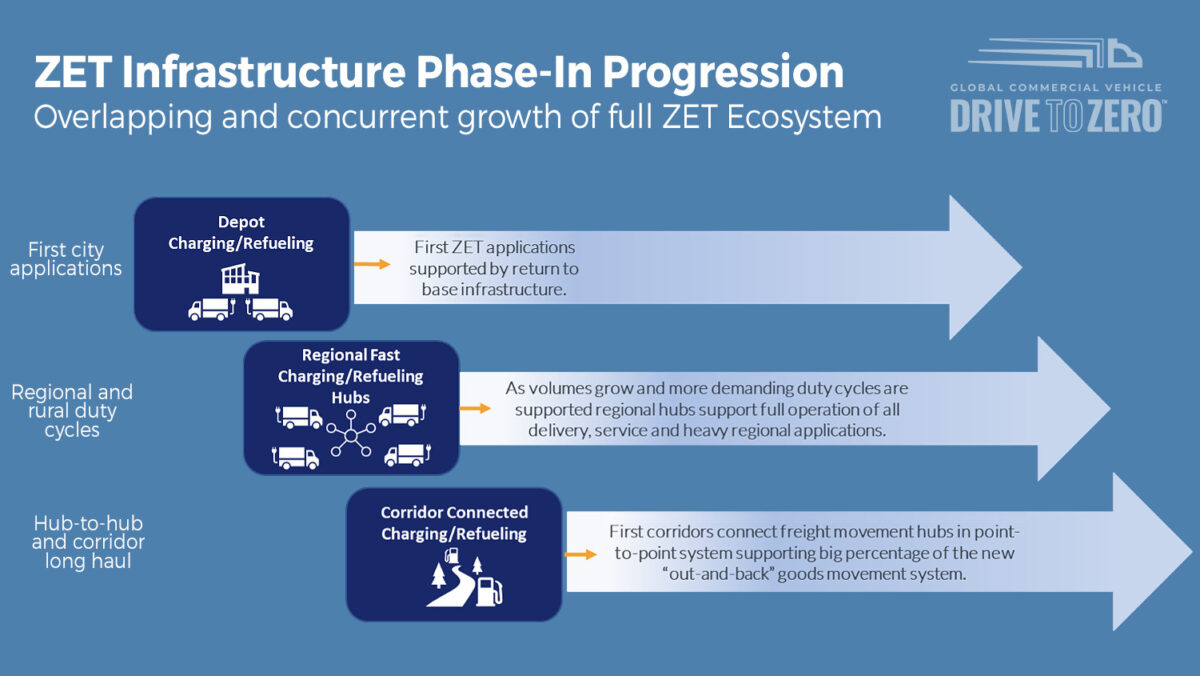Under the Global Memorandum of Understanding (Global MOU) on Zero-Emission Medium- and Heavy-Duty Vehicles (ZE-MHDV), leading nations are now working collaboratively to enable 100% zero-emission new truck and bus sales by 2040 with an interim goal of 30% zero-emission vehicle sales by 2030. MOU organizers and facilitators the Netherlands and CALSTART’s Drive to ZeroTM are hosting a series of invitation-only discussions with MOU nations. The goal is to share data and connect countries with leading technology and business experts who can support the signatories in advancing their ZE-MHDV ambitions.
Our second briefing centered on infrastructure for ZE-MHDVs. We examine the challenges and opportunities surrounding the roll-out of charging and refueling infrastructure including public-private coordination, integration into grid networks and innovative solutions. The following figure is drawn from this briefing and illustrates the progression of strategic infrastructure phase-in and deployment over time.
Key findings
- Utility investment regulatory framework – governments must enable, encourage and require utilities to plan for, invest in and take an active role in installing ZE-MHDV infrastructure at the pace required to meet rapid market growth. Government has a critical role to set the direction (through agreements, executive orders, regulations and supportive policies) for society.
- Utility rate structure – governments must encourage and require utilities and power providers to design competitive and conducive rate structures to users of zero emission commercial vehicles. Mobile customers are different than stationary customers in time of use, peak demand variability and other issues. Stationary (built environment) rates structures are not well designed to encourage electricity as a vehicle fuel. Those rates that have been established for vehicles are aimed at passenger cars (light duty), not the larger battery sizes and co-located vehicle fleet structures of commercial vehicles. Addressing electrical rate cost, time of day considerations, demand charges and other utility rate design structures and refining them for commercial vehicle success is critical.
-
Roadmapping and anticipating demand – governments can have a highly valuable role, either through internal or contractor studies, in establishing strong ZE-MHDV market demand roadmaps to assist utilities, transport ministries, municipalities and industry in preparing for and anticipating demand for charging and refueling assets needed to accommodate the rapid growth of ZECVs. These future demand assessments can include fleet depot charging, the needs for regional fast charge networks and for connecting corridors between regions. Ideally such activities will model demand growth and develop “heat charts” highlighting expected areas of vehicle charging concentration. Together with this, an overlay of utility distribution grid capacity showing stronger and weaker zones for energy delivery, will highlight areas that can accommodate immediate demand and those needing capacity expansion investments.
- Spurring Early Markets and Investments – governments have an important role to play in supporting the initial market for ZE-MHDV infrastructure and in establishing attractive conditions for private investment and capital to quickly scale these markets and assume their primary role in funding this expansion. This can take many forms: incentives and grant programs to reduce early adopter risk and “seed” first large scale deployments; risk mitigation programs for investors, such as lending rate guarantees, or longer concession/contract time periods for public contracts; and regulatory flexibility, such as allowing resale of electricity as a service. Streamlining and accelerating permitting for charging/fueling sites is also critical. The wind and solar industries have become fully cost competitive with conventional power generation in almost all areas of the world due to such structures and their lessons can be highly beneficial to adapt for the expansion of ZE-MHDVs.

